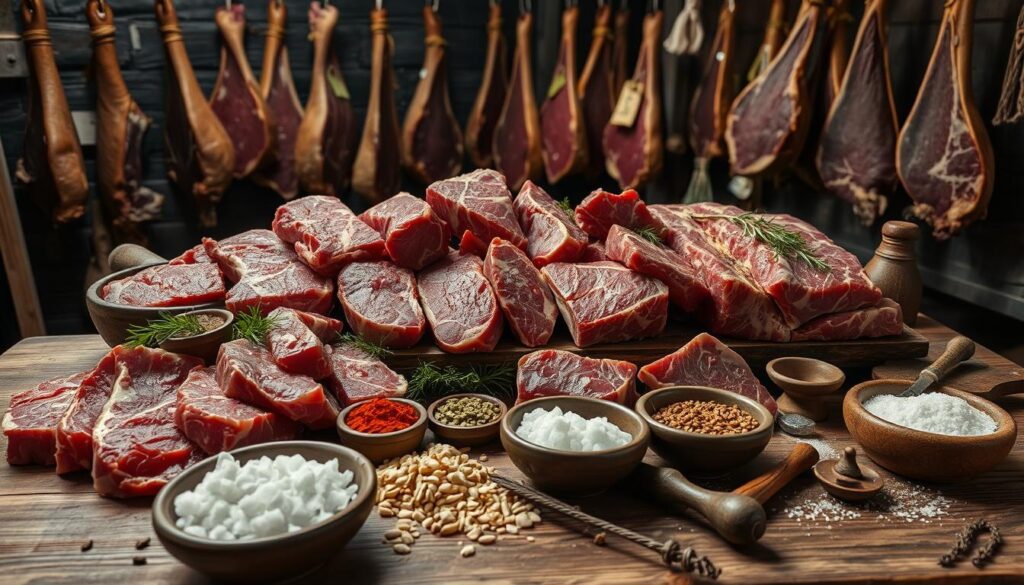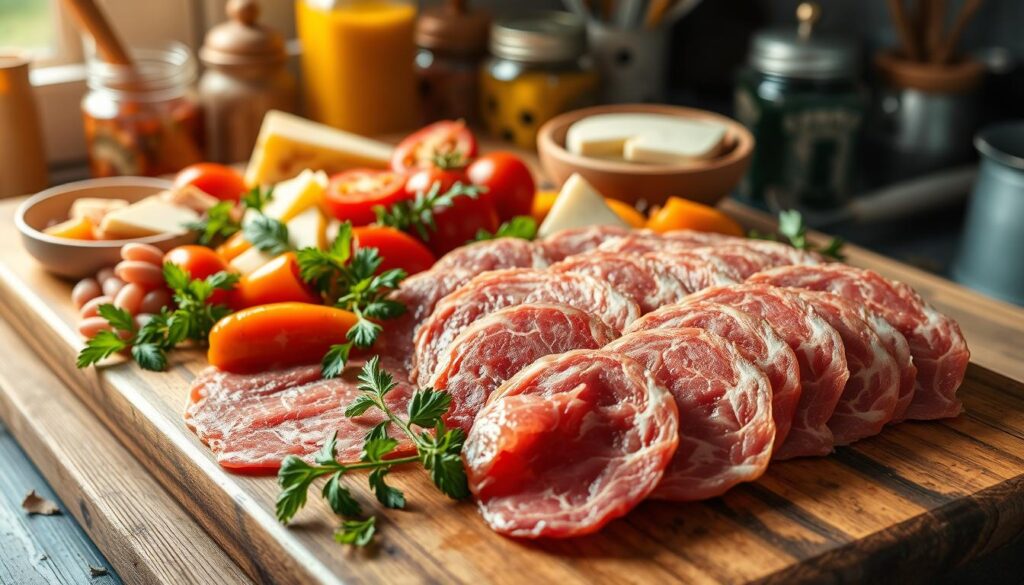When you’re putting together your charcuterie board, have you thought about the different types of thinly sliced cured beef? From the soft bresaola to the spicy pastrami, these meats bring a variety of tastes and textures. Let’s dive into the history and flavors of thinly sliced cured beef together.
Cured beef has been a key part of many cuisines for centuries. Each place has its own special way of preserving meat. You might find the dry prosciutto of Italy, the spicy guanciale of Tuscany, or the versatile summer sausage of America. These thin slices can make any dish better and excite your taste buds.
Table of Contents
Understanding Cured Beef: A Historical Perspective
The art of preserving meat has deep roots in history. Ancient civilizations like the Egyptians, Vikings, and Asian cultures used different methods to keep meat fresh. The Mesopotamians, for example, dried, salted, and stored food in sesame oil as early as 3000 BC.
By 850 BC, the Ancient Greeks were experts in smoking, drying, and salting meat. This practice spread across Europe by 200 BC.
Ancient Origins of Meat Curing
The need for reliable food preservation led to the origins of meat curing. People worldwide looked for ways to keep meat edible for longer. They used salt curing, smoking, and air-drying to do this. These early methods are the base of the cured meats we love today.
Evolution of Curing Techniques
Meat curing techniques have changed over time, showing the creativity of cultures. The term “charcuterie” comes from 15th-century France, mixing “chair” (flesh) and “cuit” (cooked). It shows how meat preservation has evolved from simple methods to today’s refined techniques.
This evolution is a testament to human innovation and the quest for tasty, lasting food.
Traditional Preservation Methods
Even with modern advancements, traditional meat preservation methods are still key. Salt curing, smoking, and air-drying are still the main ways to make cured meat. These methods, along with the skill of artisans, have created the wide variety of cured beef we enjoy today.
What is Thinly Sliced Cured Beef Called?
The world of cured beef is vast and varied. It has many regional specialties and unique preparations. Thinly sliced cured beef can be called different names depending on the product and location. Let’s look at some of the most popular ones:
Bresaola is a beloved Italian delicacy. It’s an air-dried, salted lean beef eye of round aged for about three months. This results in a deep red color and delicate flavor. Bresaola is often served in antipasto, on pizza, or in sandwiches.
Carpaccio can refer to thinly sliced cured beef, although it’s often associated with raw beef. This Italian dish involves slicing or pounding the meat into translucent pieces. It’s served with garnishes like arugula, capers, olive oil, and vinegar.
Beef prosciutto is another term for thinly sliced cured beef. It’s similar to the famous Italian ham but made from beef instead of pork.
The broader category of salumi includes a wide range of cured meat products. This includes both whole muscle cuts like bresaola and ground meat items like salami. While salami is a type of salumi, the two are not interchangeable.
Thinly sliced cured beef, no matter the name, is a delicious and versatile ingredient. It’s perfect for enhancing charcuterie boards, salads, sandwiches, and more. Exploring these regional specialties can be a true culinary adventure.
Types of Premium Cured Beef Products
Premium cured beef products have won the hearts of food lovers everywhere. They range from the Italian beef bresaola to the famous pastrami and corned beef. Each offers a unique taste and texture.
Bresaola: The Italian Delicacy
Bresaola is a special air-dried, salted beef from Italy. It’s made from the eye of round cut. Seasoned with garlic, pepper, and juniper, it’s tender and full of flavor.
Pastrami and Corned Beef Variations
Pastrami comes from Romania and is loved in many places. It’s a brisket-based dish, brined, dried, seasoned, and smoked. Corned beef is also from brisket or round, cured in a seasoned brine.
European Specialties
Europe has more than just beef bresaola, pastrami, and corned beef. There’s Spanish cecina, a smoked and dried beef, and Swiss Bündnerfleisch, an air-dried beef from the Alps. These are just a few of the many cured beef varieties found in Europe.
The Art of Beef Curing and Processing
Beef curing turns ordinary meat into amazing dishes. At its heart, the beef curing process involves detailed steps. These steps bring out the meat’s full flavor and texture, unlike regular cooking.
The first step is picking top cuts, like eye of round or brisket. These are seasoned with salt, spices, and sometimes sugar. Curing salts with nitrites or nitrates keep the meat’s color bright and stop harmful bacteria.
Next, the curing can be dry, wet (brining), or a mix of both. The meat might also be air-dried or smoked. This drying can last weeks to months, making the meat’s flavors richer and more complex.
While curing, the experts watch temperature, humidity, and environment closely. They ensure the beef is cured safely and consistently. This requires patience, skill, and respect for tradition.

Beef curing has evolved from old salting and smoking to today’s modern techniques. It fascinates food lovers everywhere. It shows the lasting value of craftsmanship and the drive for culinary perfection.
Popular Italian Cured Beef Varieties
Italy is known for its cured meats, including several tasty beef varieties. The most famous is bresaola, a dried beef from the Valtellina region. It’s known for its deep red color and mild, savory taste. It’s often served thinly sliced in antipasto platters or salads.
Carne salada from Trentino is another regional specialty. It’s cured beef with salt, spices, and herbs. Carpaccio can also be cured, offering a unique taste and texture.
Serving Suggestions
These Italian cured beefs are usually served in thin slices. They can be enjoyed on their own or as part of a spread. They go well with crusty bread, Parmigiano-Reggiano cheese, and olive oil with lemon juice.
Pairing Recommendations
The flavors of these cured beefs pair well with light red or crisp white wines. Fans of salumi food love trying different regional varieties. Each one has its own special taste.
Quality Indicators and Certifications
In the world of cured beef, quality matters a lot. European designations like PDO (Protected Designation of Origin), PGI (Protected Geographical Indication), and DOP (Denominazione di Origine Protetta) are top-notch. They ensure the beef is made in specific areas using old methods.
These labels prove the beef’s origin and keep its heritage alive. But, remember, these labels don’t always mean the beef tastes better. The French Label Rouge is different. It shows the beef is of the highest quality, with clear standards for taste.
When picking cured beef, think about these labels and what you like. Knowing about these quality signs helps you choose the best. This way, you get to enjoy the finest cured beef out there.
- PDO (Protected Designation of Origin)
- PGI (Protected Geographical Indication)
- DOP (Denominazione di Origine Protetta)
- Label Rouge
Storage and Serving Tips
Keeping your cured beef in top shape is key. Store whole pieces in a cool, dry spot or in the fridge at 35-40°F (1.6-4.4°C). After slicing, eat it within a few days. Keep it in the fridge and wrap it in wax paper or plastic wrap.
Optimal Temperature Guidelines
Serving your cured beef at room temperature is best. It lets the flavors shine and the texture be at its best. When you serve, lay out the slices neatly on a platter. This makes them look elegant and appealing.
Presentation Techniques
- Pair the cured beef with items like crusty bread, olives, and hard cheeses. This makes a beautiful and tasty charcuterie board.
- For the freshest taste, slice the cured beef right before serving. This helps it stay moist and flavorful.
By following these tips, your cured beef will stay delicious and memorable. Check out the world of cured meats and find new ways to enjoy its rich flavors.
Health Benefits and Nutritional Value
Cured beef like bresaola and pastrami is packed with nutrients. They are great sources of protein, with about 32 grams in every 100 grams. This makes them perfect for building and maintaining muscle, adding value to any diet.
These meats are also full of vitamins and minerals. They have lots of B vitamins, including vitamin B12, and zinc and iron too. These nutrients help with energy, making red blood cells, and boosting the immune system.
| Nutrient | Amount per 100g | % Daily Value |
|---|---|---|
| Protein | 32g | 64% |
| Vitamin B12 | 3.5μg | 146% |
| Iron | 3.1mg | 17% |
| Zinc | 5.1mg | 46% |
But, cured beef can also have a lot of sodium because of how it’s made. It’s best to eat it in small amounts and as part of a healthy diet to stay well.
When picking cured beef, choose options with less sodium, sugar, and nitrates/nitrites. These have raised health concerns. Also, look at where and how the beef was made to ensure it’s good for you.

Conclusion
Thinly sliced cured beef is a treasure in the world of food. It brings together flavors and textures from all over, making it a favorite among food lovers. Learning about how it’s made, what makes it good, and how to store it helps us enjoy it more.
These cured meats are perfect for many dishes, like charcuterie boards, sandwiches, or as a snack. They add a special touch to our meals. But, it’s important to eat them in balance to enjoy their full flavor and stay healthy.
Exploring thinly sliced cured beef and charcuterie is a journey through history and culture. It shows us the art of curing meats. By learning about different types and how to serve them, we can discover new flavors and deepen our love for cured meats.

